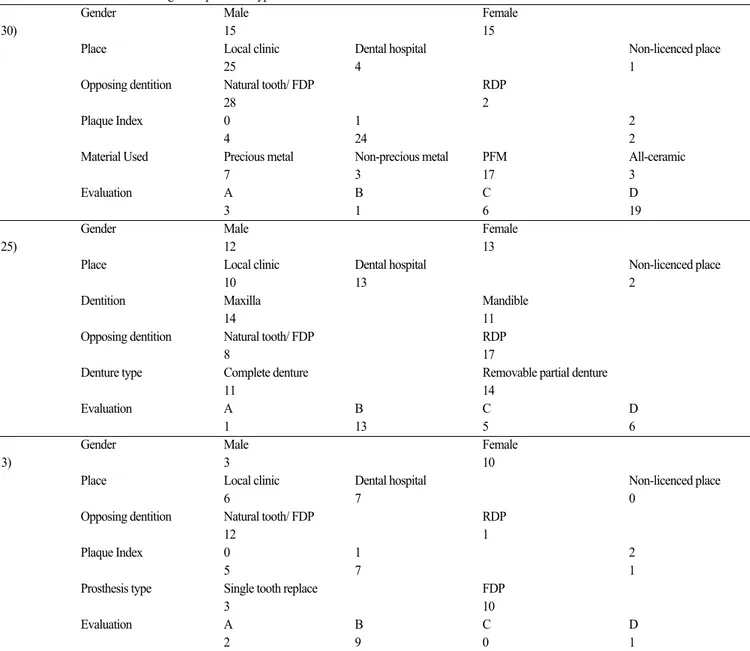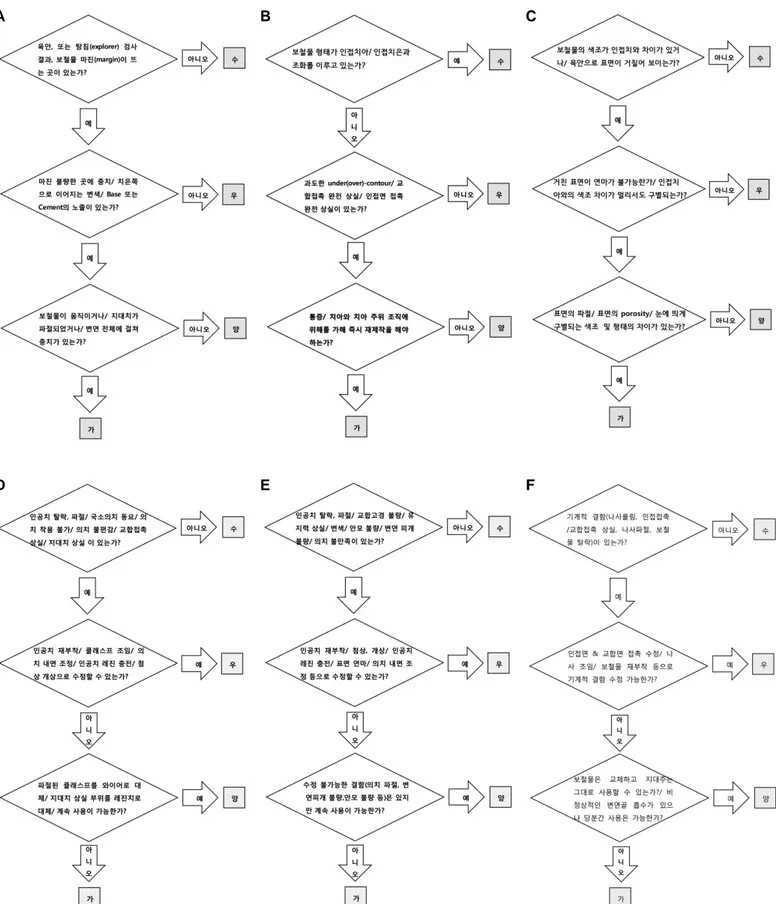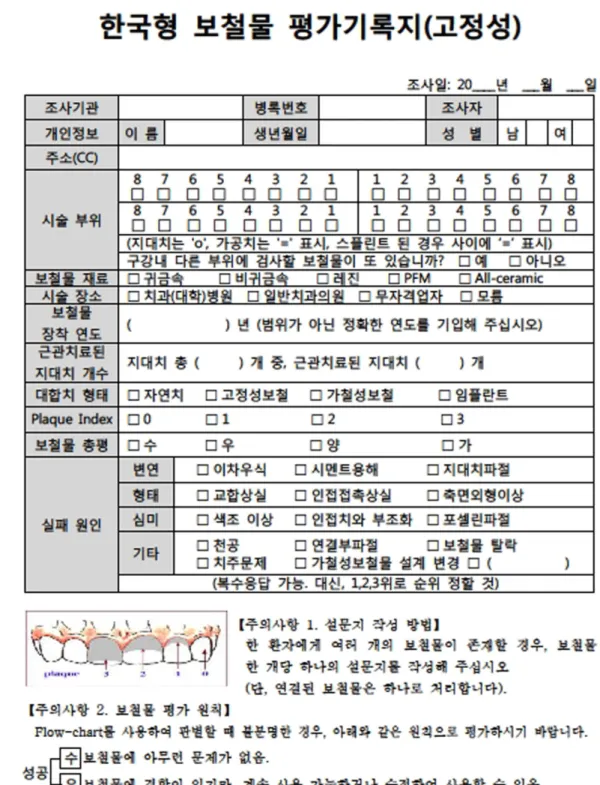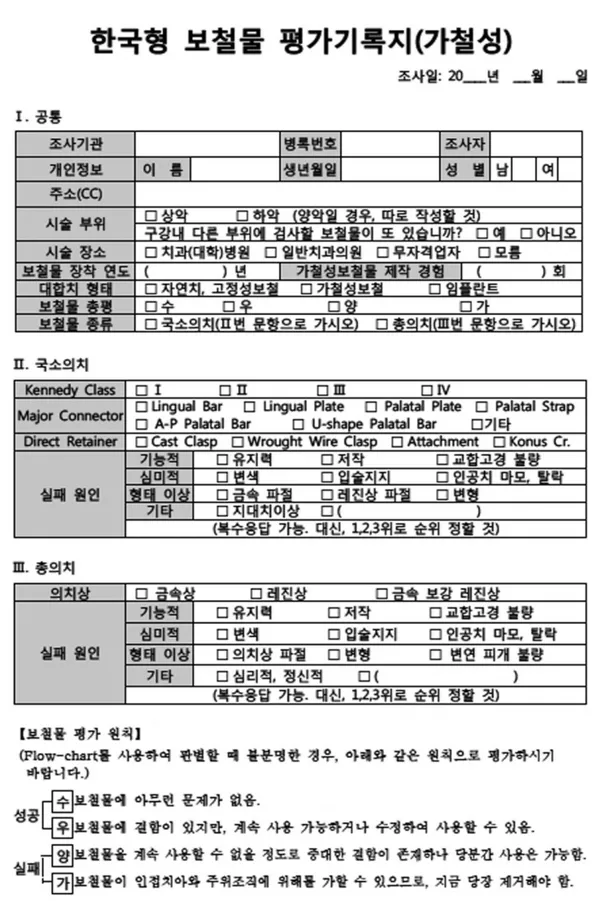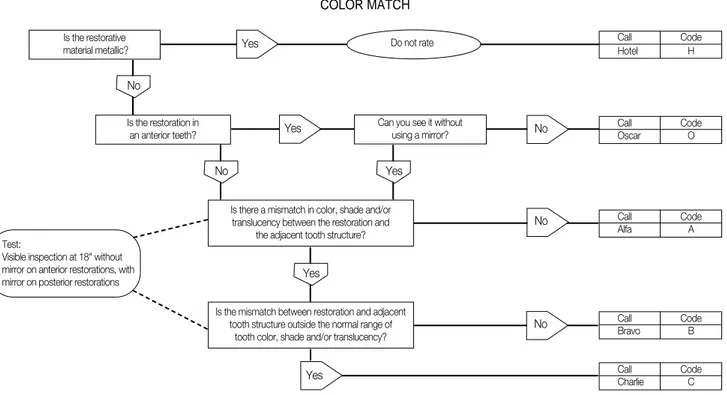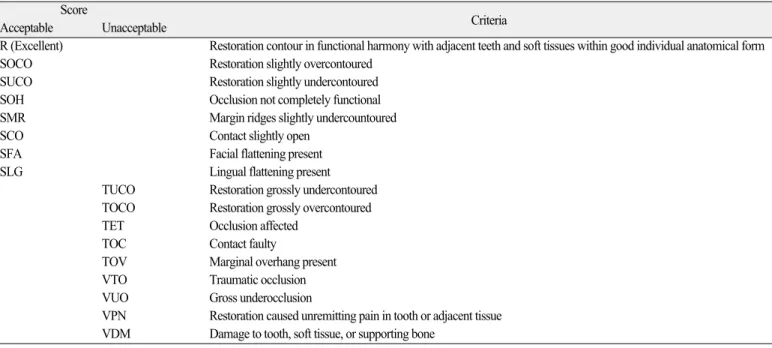서론
최근 우리 나라는 경제, 사회, 문화적인 발전으로 인해 국민 들의 생활 수준이 향상되어 구강 건강에 대한 관심이 증대되 고 있다. 이에 따라 치과 치료에 대한 수요가 증가한 반면, 치료
에 대한 불만으로 인해 환자와 치과의사 간의 분쟁도 증가하 고 있다.1이 같은 의료 분쟁은 국민의 권리 의식 신장, 의료의 상업화에 따른 의료 기술에 대한 지나친 기대, 의사의 윤리의 식 결여 및 법리에 대한 무지, 그리고 사회적 불신 풍조와 분쟁 해결을 위한 제도적 장치 결여 등 여러 가지 복합적인 요인에
보철물 수명 연구를 위한 대한치과보철학회 표준 방안: KAP Criteria
윤준호1∙박영범2∙윤승환3∙오남식4*
1국민건강보험 일산병원 치과보철과, 2연세대학교 치과대학 치과보철학교실,
3연세메이트치과 보철과, 4인하대학교 의학전문대학원 치과 보철과
Korea Academy of Prosthodontics criteria for longevity studies of dental prostheses
Joon-Ho Yoon1, Young-Bum Park2, Seung-Hwan Youn3, Nam-Sik Oh4*
1Department of Prosthodontics, School of Dentistry, NHIS Ilsan Hospital, Goyang, Republic of Korea
2Department of Prosthodontics, School of Dentistry, Yonsei University, Seoul, Republic of Korea
3Department of Prosthodontics, Yonsei Mate Dental Clinic, Seoul, Republic of Korea
4Department of Prosthodontics, School of Medicine, Inha University, Incheon, Republic of Korea
Purpose: The most important factor in longevity studies of dental prostheses is objective and consistent evaluation of the prosthesis. The Korean Academy of Prosthodontics suggested developing a standardized method for longevity studies of dental prostheses. The purpose of this study is to evaluate previously-used criteria and to develop new cri- teria, in the form of a procedure flowchart and an evaluation sheet. These new criteria may be able to provide a unified standard for future longevity studies of dental prostheses.
Materials and methods: A literature review was performed about the evaluation of dental prostheses. Taking into account the strengths and weaknesses of previously used criteria, a novel, intuitive and objective method was developed for assessment of dental prostheses. Then, a pilot survey was performed with the newly developed flowchart and evaluation sheet to determine problems and implement possible improvements. Results: Thirty cases of fixed dental prosthesis (FDP), 25 cases of removable dental pros- thesis (RDP), and 13 cases of implant supported prosthesis (ISP) were evaluated. The average life expectancy estimate was 12.82 years for FDP, 5.96 years for RDP, and 4.82 years for ISP with Kaplan-Meier survival analysis. Additionally, possible improvements discovered by the pilot survey were reflected in the flowchart and evaluation sheet.
Conclusion: The newly developed KAP criteria, flowchart and evaluation sheet enabled objective and consistent results in trial longevity studies of dental prostheses. It is expect- ed that future studies will not only use the KAP criteria but also further improvement will be made on them. (J Korean Acad Prosthodont 2016;54:341-53)
Keywords: Life expectancy of dental prosthesis; Survival rate; Kaplan-Meier analysis; Prostheses and implant; Data collection
c cc
2016 The Korean Academy of Prosthodontics
This is an Open Access article distributed under the terms of the Creative Commons Attribution Non-Commercial License (http://creativecommons.org/licens- es/by-nc/3.0) which permits unrestricted non-commercial use, distribution, and reproduction in any medium, provided the original work is properly cited.
*Corresponding Author: Nam-Sik Oh
Department of Prosthodontics, School of Dentistry, Inha University, 100 Inharo, Nam-gu, Incheon 22212, Republic of Korea +82 (0)32 890 2470: e-mail, onsdo@inha.ac.kr
Article history: Received February 26, 2016 / Last Revision April 11, 2016 / Accepted June 7, 2016
※This research was performed with the partial support of Korean Academy of Prosthodontics in the year of 2014.
기인한다. 또한 인터넷 등을 통해 의료사고와 관련된 정보의 생산과 유통이 급속도로 증가하는 현상 또한 간과할 수 없다.2
의료 분쟁이 일어났을 때 당사자들이 합리적으로 분쟁을 조 정하기 위해 근거에 입각한 정보를 얻는 것이 중요하다. 그럼 에도 불구하고 인터넷에 유통되고 있는 경험적, 주관적 정보 를 통해 분쟁 당사자들이 각자의 주장을 뒷받침하고 있어 분 쟁의 조정이 어려운 경우가 많다. 조기에 실패한 보철물로 인 한 의료분쟁이 일어났을 때, 당사자들 간의 합리적인 분쟁의 조정을 위해서는 보철물 수명에 대한 객관적인 자료가 필요하 다.
현재까지 국내외에서 보철물의 수명에 대해 많은 연구가 이 루어졌다. Schwartz 등3의 연구에서는 3년 동안 내원한 환자들 중 보철물의 재제작을 필요로 하며, 보철물의 장착 시기를 정확 하게 인지하고 있는 406명을 대상으로 실패한 보철물의 평균 사용기간 및 실패 원인을 분석하였다. 이 연구가 시행된 이후 재 치료가 요구되는 보철물을 검사하여 평균 사용 기간을 분 석한 연구들이 이루어졌으나4연구의 수가 적고, 1990년대 이전 에 시행된 오랜 연구들이다. 이는 이 연구들이 후향적인 연구 이기 때문에 환자의 기억 또는 진료 기록을 통해서만 판단이 가능하여 실패한 보철물의 처음 상태를 알 수 없기 때문에 신 뢰성이 떨어지기 때문인 것으로 보인다.
따라서 1990년대 이후 최근까지 전향적 연구5-15및 메타분석
법16-18등을 통해 조금 더 근거 수준이 높은 연구들이 시행되고
있다. 하지만 보철물 수명에 관한 직접적인 수치가 제시되기 보다 관찰 기간 동안의 실패율과 성공률을 통해 간접적으로 보철물의 수명을 판단할 수밖에 없기에 의료 분쟁의 조정 등 에 참고 자료로 이용하기에는 현실적으로 어려움이 따른다.
국내에서는 2001년 대한치과보철학회 주관으로‘보철물의 수명에 관한 연구’가 시행되어 그에 대한 보고서가 발간되었 다. 하지만 보철물 실패에 대한 객관적인 기준이 모호하고, 검 사자의 표준화에 대해 언급이 되고 있지 않으며, 2개월 간의 짧 은 조사 기간으로 인해 광범위한 조사가 이루어지지 못했다는 문제점이 지적되고 있다. 또한 임플란트가 보편화 되기 이전 인 시대적인 배경으로 인해 임플란트 보철물의 수명에 대한 보고가 시행되지 않았다. 이후 10년 동안 국내 보철물의 수명 에 관한 연구가 보고된 바 있으나19,20연구에 포함된 피험자 수 가 소수이거나 단일 기관의 피험자에 한정되었다는 한계가 있 어 이를 보편적인 보철물의 수명으로 일반화하기 어렵다. 이 에 따라 기존에 시행된 보철물 수명에 관한 조사를 보완하여 시대에 맞는 기준을 제시할 필요성이 있다. 따라서 대한치과 보철학회에서는 보철물 수명 연구에서 가장 중요한 쟁점 중 하나인 보철물의 성공/실패를 평가하기 위한 표준화된 기준을 제시하여 이를 통해 객관적인 보철물의 평가가 이루어지게 하 고, 자료들의 수집을 통일화하기 위해 보철물 수명에 대한 평 가 기록지를 제작할 필요성이 대두되었다.
일반적으로 보철물의 상태를 평가하는 기준으로 문헌에서 가장 많이 사용되고 있는 기준은 United States Public Health Service
(USPHS) Criteria와 California Dental Association (CDA) Guideline이다.
USPHS Criteria는 1971년 Cvar와 Ryge21에 의해 만들어진 것으로 수 복물을 평가하는 데 주로 사용되어 왔다. CDA Guideline은 캘리 포니아 치과 협회에 의해 1977년에 만들어졌고, 1995년에 수정 되어 현재까지 사용되고 있다.22본 연구의 목적은 이 두 가지 보철물 평가 기준을 기초로 새로운 보철물의 평가 기준을 마 련하여 보다 더 직관적이고 객관적인 보철물의 평가가 이루어 질 수 있도록 하는 데 있고, 이를 통해 향후 통일된 기준으로 보 철물 수명 연구 결과가 이루어지게 하는 데 있다.
재료 및 방법
1. 보철물 평가 기준 개발
객관적이고, 쉽게 적용 가능한 USPHS Criteria와 보다 객관적 이고 자세한 CDA Guideline을 접목시키고, 임상에서 자주 만나 는 실패의 유형들을 첨가하여 한국형 보철물 평가 기준(KAP Criteria)을 제작하게 되었다. 또한 위의 두 평가 기준이 보철물 (prosthesis)의 평가가 아닌 충전물 또는 인레이 등의 수복물 (restoration) 평가를 위해 만들어졌기 때문에 가철성 보철물과 임플란트 보철물을 평가할 수단이 아직까지 마련되어 있지 않 았다. 따라서 이번 연구를 통해 고정성 보철물의 평가 기준과 함께 가철성 보철물 및 임플란트 보철물의 평가 기준도 함께 제작하였다.
1) 평가 등급
한국인들에게 익숙한 등급인‘수-우-미-양-가’등급에서
‘미’를 제외하고 남은‘수’와‘우’를 성공, 그리고‘양’과‘가’
를 실패로 규정하였다. 여기에서‘수’는 보철물에 전혀 이상이 없는 상태를; ‘우’는 약간의 이상이 있으나 인접치아와 치아 주변 조직에 해를 가하지 않고 수정이 가능한 상태를; ‘양’은 보철물이 치아와 주변 조직에 잠재적으로 해를 가할 수 있으 므로 재제작이 필요하나 현재 상태로 당분간 보철물의 사용이 가능한 상태를; 마지막으로‘가’는 즉각적으로 재제작이 요구 되는 보철물의 상태를 의미한다. 만약 제작된 flow-chart (평가흐 름도)에 명시되지 않았거나, 상태가 애매하여 평가를 내리기 어려운 경우 위에 기술한 대로 기준을 적용할 수 있다.
2) 보철물 평가 흐름도
고정성 보철물의 변연, 형태, 그리고 심미평가, 가철성 보철 물인 총의치와 국소의치의 평가, 마지막으로 임플란트 보철물 의 평가를 평가흐름도의 형식으로 제작하여 각각의 평가 질문 에 맞는 평가 등급을 선택하도록 하였다.
2. 평가 기준 및 평가 기록지 초안의 시범 시행
제작된 보철물 평가 기준 및 보철물 평가 기록지를 연세대학
교 치과대학병원, 인하대학교 병원, 국민건강보험 일산병원 보 철과 총 3개 기관에서 2014년 7월 1일부터 7월 31일까지 총 1개 월간 시범 사용하여 보철물의 평가와 기록을 시행하였다. 고 정성 보철물 30 증례, 가철성 보철물 25증례, 그리고 임플란트 보철물 13 증례, 총 68 증례를 평가 기준을 위한 평가흐름도와 평가기록지에 기록하였다. 평가 결과 수와 우 등급의 경우 성 공으로, 양과 가 등급의 경우 실패로 간주하였고 이 결과를 가 지고 생존율을 분석하였다. 시범 시행된 결과의 분석은 Kaplan- Meier 생존율 분석을 사용하였다. 이후 검사자들이 경험한 문제 점들을 바탕으로 평가 기준 및 평가 기록지를 수정, 보완하였 다.
결과
1. 시범 평가 분석 결과
3개 기관에서 고정성 보철물 30 증례, 가철성 보철물 25 증례, 그리고 임플란트 보철물 13 증례를 개발된 보철물 평가 기준으 로 검사하고 보철물 평가 기록지를 이용하여 각각의 결과를 기록하였다. Kaplan-Meier 생존율 분석을 통해 나타난 생존시 간의 평균 및 중위수 (Table 1)는 고정성 보철물의 경우 12.82년, 10.00년, 가철성 보철물의 경우 5.96년, 5.00년, 그리고 임플란트 보철물의 경우 4.82년, 3.00년으로 나타났다. 생존율 그래프는 그림과 같다 (Fig. 1). 각각의 보철물 종류에 따른 결과 분포를 표 에 정리하여 나타내었다 (Table 2).
Table 1. Mean and median of longevity of evaluated prostheses
Mean Median
Type Estimate SD 95% CI
Estimate SD 95% CI
Min Max Min Max
FDP 12.821 1.681 9.527 16.116 10 1.319 7.414 12.586
RDP 5.955 0.973 4.048 7.861 5 1.563 1.936 8.064
ISP 4.818 1.299 2.272 7.364 3 0.826 1.382 4.618
* FDP: Fixed Dental Prosthesis; RDP: Removable Dental Prosthesis; ISP: Implant Supported Prosthesis; SD: Standard Deviation; CI: Confidence Interval; Min: Minimum;
Max: Maximum
Fig. 1. (A) Survival curve of fixed dental prostheses, (B) Survival curve of removable dental prostheses, (C) Survival curve of implant supported prostheses.
*CSR: Cumulative Survival Rate.
CSR
1.0 0.8 0.6 0.4 0.2 0.0
0 10 20 30 40 Year
Fixed Dental Prosthesis
CSR
1.0 0.8 0.6 0.4 0.2 0.0
0 10 20 30 40 Year
Removale Dental Prosthesis
CSR
1.0 0.8 0.6 0.4 0.2 0.0
0 4 8 12 Year
Implant Supported Prosthesis
A B
C
2. 평가 기준
시범 평가를 통해 조사자들이 지적한 문제점들을 해결하여 수정, 보완된 보철물 평가 기준을 아래 그림으로 첨부하였다.
고정성 보철물의 경우 보철물의 형태, 변연, 심미의 세가지 기 준으로 구분되었고, 가철성 보철물의 경우 총의치와 국소의치 를 나누어서 제작하였으며, 임플란트 평가 기준을 별도로 제 작하였다 (Fig. 2).
3. 보철물 평가 기록지
또한 각각의 평가 등급을 기록하여 자료화 할 수 있는 평가 기록지를 고정성, 가철성, 그리고 임플란트 보철물에 맞게 각 각 제작하였다 (Fig. 3).
Table 2. Distribution of the cases according to the prosthetic type
FDP Gender Male Female
(N = 30) 15 15
Place Local clinic Dental hospital Non-licenced place
25 4 1
Opposing dentition Natural tooth/ FDP RDP
28 2
Plaque Index 0 1 2
4 24 2
Material Used Precious metal Non-precious metal PFM All-ceramic
7 3 17 3
Evaluation A B C D
3 1 6 19
RDP Gender Male Female
(N = 25) 12 13
Place Local clinic Dental hospital Non-licenced place
10 13 2
Dentition Maxilla Mandible
14 11
Opposing dentition Natural tooth/ FDP RDP
8 17
Denture type Complete denture Removable partial denture
11 14
Evaluation A B C D
1 13 5 6
ISP Gender Male Female
(N=13) 3 10
Place Local clinic Dental hospital Non-licenced place
6 7 0
Opposing dentition Natural tooth/ FDP RDP
12 1
Plaque Index 0 1 2
5 7 1
Prosthesis type Single tooth replace FDP
3 10
Evaluation A B C D
2 9 0 1
* FDP: Fixed Dental Prosthesis; RDP: Removable Dental Prosthesis; ISP: Implant Supported Prosthesis; PFM: Porcelain Fused to Metal
Fig. 2. (A) Flow-chart for evaluating fixed dental prostheses with KAP criteria: marginal integrity, (B) Flow-chart for evaluating fixed dental prostheses with KAP criteria:
anatomic form, (C) Flow-chart for evaluating fixed dental prostheses with KAP criteria: esthetic evaluation, (D) Flow-chart for evaluating removable partial dentures with KAP criteria, (E) Flow-chart for evaluating complete dentures with KAP criteria, (F) Flow-chart for evaluating implant supported prostheses with KAP criteria.
A B C
D E F
Fig. 3. (A) Evaluation sheet for fixed dental prostheses, (B) Evaluation sheet for removable dental prostheses, (C) Evaluation sheet for implant supported prostheses.
A
B
Fig. 3. (continued) (A) Evaluation sheet for fixed dental prostheses, (B) Evaluation sheet for removable dental prostheses, (C) Evaluation sheet for implant supported prostheses.
C
Fig. 3. (continued) (A) Evaluation sheet for fixed dental prostheses, (B) Evaluation sheet for removable dental prostheses, (C) Evaluation sheet for implant supported prostheses.
고찰
이상과 같이, 본 연구를 통하여 보철물을 평가하기 위한 보 철물 평가 흐름도와 보철물 실패에 영향을 미치는 요인들을 살펴보기 위한 보철물 평가 기록지를 제작해 보았다. 본 평가 흐름도가 보철물의 성공과 실패를 규정하는 데에 객관적인 도 구가 되어 한국인의 보철물 수명을 측정하는 데에 도움이 되 고, 또한 보철물이 실패하게 되는 요인을 분석하는 도구로 본 평가 기록지가 중요하게 사용될 수 있을 것으로 기대된다. 또 한 향후 국내에서 행해지는 보철물 수명 연구에서 연구자들이 통일된 기준을 사용한다면 일관성 있는 자료수집이 이루어지 고, 각 연구자 간, 시대별, 지역별 연구결과를 비교, 분석하는 데 유용할 것이다.
지금까지 널리 사용되어 왔던 평가 방법은 UHPHS criteria와 CDA guideline으로 크게 나눌 수 있다. 이번 보철물 평가 방법은 두 가지 평가 방법의 장단점을 수정, 보완하여 제작한 것으로 각각의 평가 방법의 특징을 간단히 설명하면 다음과 같다. 먼 저 USPHS criteria는 다섯 가지의 범주로 수복물을 평가한다: 색 조 적합도; 변연의 변색; 해부학적 형태; 변연 적합도; 치아 우 식. 각각의 범주 마다 평가흐름도의 형태로 수복물을 평가하 는 기준을 제시하고 그 기준에 부합되는지의 여부에 따라 하 부 평가 기준으로 넘어가는 형태이다. 최종 평가 결과를 O (Oscar); A (Alpha); B (Bravo); C (Charlie)의 네 가지 등급으로 나누 어서 C 등급일 경우 해당 수복물을 실패로 간주하였다. 아래에 USPHS criteria 중 색조 적합도에 대한 예시를 첨부하였다 (Fig. 4).
USPHS criteria는 수복물을 평가하는 데 있어 몇 가지의 상위, 하위 질문들을 평가흐름도의 형식으로 배치하여 단계에 따라 최종 평가에 이르게 함으로서 평가자가 직관적으로 결과에 도 달할 수 있다는 장점이 있다. 하지만 평가 질문들 중 객관적이 지 않은 것이 섞여 있고, 몇 가지 평가 질문만으로 결과에 도달 해야 하는 등 주관적인 요소가 개입될 가능성이 여전히 존재 한다는 단점이 있다.
CDA guideline은 1977년 캘리포니아 치과 협회에서 만든 것으 로, 보철물의 평가 기준을 조금 더 세부화하여 제시하였다. 표 면과 색조, 해부학적 형태, 그리고 변연 적합도의 세가지 범주 에서 각각 R (Romeo); S (Sierra); T (Tango); V (Victor)의 네 가지 등 급으로 평가한다. 평가 결과 R과 S 등급은 적합으로, T와 V 등 급은 부적합, 즉 실패한 보철물로 간주된다. 각각의 등급에 해 당하는 경우를 약자를 이용하여 자세하게 설명하고 있어서 평 가자가 보철물을 검사하고 해당 보철물이 어떤 상태에 해당하 는지에 따라 보철물의 등급을 선택할 수 있게 되어있다. 초기 의 평가 기준이 1995년에 수정이 되어 현재까지 많은 문헌에서 보철물의 평가 기준으로 사용되고 있다. CDA guideline에 대해 아래의 표를 통해 조금 더 자세하게 기술한다 (Table 3).
CDA guideline은 USPHS criteria 보다 더 자세하게 보철물 실패 의 상황들이 나열되어 있어 USPHS criteria보다 더 객관적인 보철 물의 평가가 이루어질 수 있다. 하지만 너무 자세하게 기준이 제시되어 있어 검사자가 CDA guideline에 해당하는 모든 기준을 습득하는 데에 많은 시간이 필요하고, 보철물 평가에 걸리는 시간 또한 많이 소요된다는 단점이 존재한다.
Fig. 4. An example of flow-chart in color match tab of USPHS criteria.
Is the restorative material metallic?
Is the restoration in an anterior teeth?
Is there a mismatch in color, shade and/or translucency between the restoration and
the adjacent tooth structure?
Is the mismatch between restoration and adjacent tooth structure outside the normal range of
tooth color, shade and/or translucency?
COLOR MATCH
Test:
Visible inspection at 18" without mirror on anterior restorations, with mirror on posterior restorations
Yes
Call Code
Hotel H
Call Code
Oscar O
Call Code
Alfa A
Call Code
Bravo B
Call Code
Charlie C
No
No Yes
Yes
Do not rate Yes
Can you see it without using a mirror?
Yes No
No
No
Table 3A. Category and score of margin integrity in CDA guidelines Score
Criteria Acceptable Unacceptable
R (Excellent) No visible evidence of crevice along margin that explorer would penetrate; no evidence of ditching along margin SCR Visible evidence of slight marginal discrepancy with no evidence of decay, repair possible but perhaps unnecessary;
explorer gets stuck in one direction TFAM Faulty margins cannot be properly repaired
TPEN Penetrating discoloration along margin of restoration in pulpal direction TCEM Retained excess cement
VMO Mobile restoration
VFR Fractured restoration
VCAR Caries continuous with margin of restoration VTF Fractured tooth structure
Table 3B. Category and score of anatomic form in CDA guidelines Score
Criteria Acceptable Unacceptable
R (Excellent) Restoration contour in functional harmony with adjacent teeth and soft tissues within good individual anatomical form
SOCO Restoration slightly overcontoured
SUCO Restoration slightly undercontoured
SOH Occlusion not completely functional
SMR Margin ridges slightly undercountoured
SCO Contact slightly open
SFA Facial flattening present
SLG Lingual flattening present
TUCO Restoration grossly undercontoured TOCO Restoration grossly overcontoured
TET Occlusion affected
TOC Contact faulty
TOV Marginal overhang present
VTO Traumatic occlusion
VUO Gross underocclusion
VPN Restoration caused unremitting pain in tooth or adjacent tissue VDM Damage to tooth, soft tissue, or supporting bone
Table 3C. Category and score of color and surface in CDA guidelines Score
Criteria Acceptable Unacceptable
R (Excellent) No mismatch in color shade or translucency between restoration(s) and adjacent teeth; restoration surface smooth; no irritation of adjacent tissue
SMM Slight mismatch between shade of restoration(s) and adjacent tooth or teeth SRO Restoration surface slightly rough but can be polished
TGI Grossly irregular surface not related to anatomy and not subject to correction
TMM Mismatch between restoration(s) and adjacent tooth or teeth outside normal range of color, shade, or translucency
VSF Fractured surface
VGP Gross porosities in crown material
VSD Shade in gross disharmony with adjacent teeth
보철물의 수명에 관한 자료는 의료 수요자에게 객관적 수치 를 제시함으로 인해 효과적인 치료계획을 수립하는 데 도움을 주고, 날로 증가하는 의료분쟁에서 배상액을 산정하는 데 영 향을 미칠 수 있는 중요한 도구가 된다. 지금까지 보철물 수명 에 관련된 많은 연구들이 수행되었고, 이를 통해 많은 문헌 보 고가 이루어졌지만, 국내에서 시행된 연구의 수와 이를 통해 발표된 문헌의 수는 매우 제한적이다.
Walton 등4은 고정성 보철물의 평균수명을 8.3년으로 보고하 였다. 대부분의 실패 원인은 이차우식이었으며(22%), 보철물 재제작의 이유는 구강내 질병으로 인한 것(28.5%)보다는 기계 적인 문제, 즉 도재의 파절이나 심미성 때문인 경우(69.5%)가 더 높다고 하였다. 레진전장금속관의 평균수명은 13.9년으로 가 장 길었던 반면, 금속도재관의 평균수명은 6.5년으로 비교적 짧았다.4Vermeulen 등23은 가철성 국소의치 5년, 10년 생존율을 조 사하였다. 1480명의 환자에게 가철성 국소의치를 시술한 다음, 해당 환자들을 6개월에 한번씩 정기적으로 내원하도록 하여 검진을 시행하였는데, 이 결과 가철성 국소의치의 5년 생존율 은 75%이며, 10년 생존율은 50%로 보고하였다.
국내에서 시행된 보철물 수명 연구는 2001년 대한치과보철 학회에서 시행한 것이 있다.19실패한 보철물의 재치료를 위해 내원한 환자들을 대상으로 보철물의 평균 수명을 조사한 결 과, 전체 보철물 중 치료 후 재치료가 요구되기까지의 평균기 간은 보철물 종류에 관계 없이 7.54년이었다. 이를 각각의 보철 물 종류에 따라 분류하면 고정성 보철물은 7.67년, 가철성 국소 의치는 7.03년, 그리고 총의치는 6.86년으로 서로 비슷한 수치를 나타내었다.
이번에 제작된 보철물 평가 흐름도와 평가 기록지를 시범 사 용한 결과, 과거에 보고된 보철물의 수명과 상이한 수치를 나 타내고 있다. 고정성 보철물의 평균 수명 추정치는 12.82년으로 과거 국내외의 보고보다 큰 값을 나타내고 있고, 가철성 보철 물과 임플란트 보철물의 평균수명 추정치는 각각 5.96년, 4.82년 으로 낮은 값을 나타내었다. 이는 여러 가지 원인으로 설명할 수 있는데, 먼저 과거의 보고들과 이번 연구들 간의 평가 기준 이 다르고, 검사자의 주관적 기준에 따라 실패한 보철물의 유 무가 다르게 평가되었을 가능성을 제시할 수 있다. 두번째로, 시범 조사의 표본 수가 고정성 보철물 30 증례, 가철성 보철물 25 증례, 임플란트 보철물 13 증례로 매우 적은 것을 들 수 있다.
이들 결과의 중위수를 보면 추정치와 동떨어져 있는 것을 볼 수 있었는데, 이는 표본의 수가 적어 한 두 개의 극단적인 결과 들이 추정치를 한쪽으로 기울어지게 만들었다는 것을 추론할 수 있었다. 마지막으로, 이번 연구와는 반대의 결과를 나타냈 지만 이전 연구들이 가진 한계점을 설명하면, 이전 연구들의 평균수명은 환자가 실패한 보철물에 대한 주소를 호소하며 내 원한 시점을 기준으로 보철물의 수명을 측정하였는데, 보철물 의 실패는 이미 그 이전부터 발생했을 가능성이 존재할 수 있 어 보철물 수명이 오히려 길게 나타날 수 있다는 것이다. 따라 서 좀더 정확한 보철물의 수명연구를 위해서는 내원한 환자들
을 무작위로 추출하여 정상 보철물과 실패한 보철물 모두를 검사한 다음, 각 보철물들의 사용연한을 알아보아 생존율곡선 을 통해 추정 수명을 얻어야 할 것이다. 또한 적은 표본으로 얻 은 결과만으로 본 보철물 평가 흐름도가 다른 보철물 수명 평 가 방법과 비교하여 신뢰도와 타당성이 있는지를 검증하는 데 에 한계가 있었다. 향후, 본 평가 흐름도와 평가 기록지를 이용 한 광범위한 보철물 수명 조사가 시행되어, 본 평가 흐름도와 평가 기록지의 장점과 한계점이 발견되어야 할 것이고, 미비 한 점이 발견되었을 때 이를 수정, 보완하는 과정이 필요하다.
또한 평가 방법의 신뢰도와 타당성이 검증되어 이를 통해 단 일한 평가 기준으로 다양한 보철물 수명 연구가 이루어진다면 환자와 치과의사, 그리고 정책 결정자에게 유용한 자료로 사 용될 수 있을 것이다.
결론
보철물 수명 연구를 위한 대한치과보철학회 표준 방안의 마 련을 위해 현재까지 문헌에 나타난 평가 기준을 살펴보고 이 를 수정, 보완하여 새로운 보철물 평가 흐름도와 보철물 평가 기록지를 제작하였다. 이를 시범 사용하여 보철물 수명 시범 조사를 시행하였고, 평가 흐름도 및 기록지의 문제점과 개선 점을 파악하여 반영한 후, 보철물 수명 연구를 위한 대한치과 보철학회 표준방안을 완성하였다. 향후 본 보철물 평가 흐름 도 및 평가 기록지를 이용하여 보철물 수명에 관한 연구가 수 행될 예정이다.
ORCID
Joon-Ho Yoon http://orcid.org/0000-0002-4571-7342
References
1. Kwon BK, Ahn HJ, Kang JK, Kim JY, Choi JH, The jurisdictional precedent analysis of medical dispute in dental field. J Oral Med Pain 2006;31:283-96.
2. Cha YR, Kwon JS, Choi JH, Kim JY. The analysis of the current status of medical accidents and disputes researched in the Korean web sites. J Oral Med Pain 2006;31:297-316.
3. Schwartz NL, Whitsett LD, Berry TG, Stewart JL. Unserviceable crowns and fixed partial dentures: life-span and causes for loss of serviceability. J Am Dent Assoc 1970;81:1395-401.
4. Walton JN, Gardner FM, Agar JR. A survey of crown and fixed partial denture failures: length of service and reasons for re- placement. J Prosthet Dent 1986;56:416-21.
5. Glantz PO, Nilner K, Jendresen MD, Sundberg H. Quality of fixed prosthodontics after 15 years. Acta Odontol Scand 1993;51:247- 52.
6. Glantz PO, Nilner K, Jendresen MD, Sundberg H. Quality of fixed prosthodontics after twenty-two years. Acta Odontol Scand 2002;60:213-8.
7. Holm C, Tidehag P, Tillberg A, Molin M. Longevity and qual- ity of FPDs: a retrospective study of restorations 30, 20, and 10 years after insertion. Int J Prosthodont 2003;16:283-9.
8. Hämmerle CH, Ungerer MC, Fantoni PC, Brägger U, Bürgin W, Lang NP. Long-term analysis of biologic and technical aspects of fixed partial dentures with cantilevers. Int J Prosthodont 2000;13:409-15.
9. Lindquist E, Karlsson S. Success rate and failures for fixed partial dentures after 20 years of service: Part I. Int J Prosthodont 1998;11:133-8.
10. Sundh B, Odman P. A study of fixed prosthodontics performed at a university clinic 18 years after insertion. Int J Prosthodont 1997;10:513-9.
11. Libby G, Arcuri MR, LaVelle WE, Hebl L. Longevity of fixed partial dentures. J Prosthet Dent 1997;78:127-31.
12. Leempoel PJ, Käyser AF, Van Rossum GM, De Haan AF. The survival rate of bridges. A study of 1674 bridges in 40 Dutch gen- eral practices. J Oral Rehabil 1995;22:327-30.
13. Palmqvist S, Swartz B. Artificial crowns and fixed partial den- tures 18 to 23 years after placement. Int J Prosthodont 1993;6:279- 85.
14. Valderhaug J. A 15-year clinical evaluation of fixed prosthodontics.
Acta Odontol Scand 1991;49:35-40.
15. Karlsson S. A clinical evaluation of fixed bridges, 10 years following insertion. J Oral Rehabil 1986;13:423-32.
16. Pjetursson BE, Tan K, Lang NP, Brägger U, Egger M, Zwahlen M. A systematic review of the survival and complication rates of fixed partial dentures (FPDs) after an observation period of at least 5 years. Clin Oral Implants Res 2004;15:667-76.
17. Scurria MS, Bader JD, Shugars DA. Meta-analysis of fixed par- tial denture survival: prostheses and abutments. J Prosthet Dent 1998;79:459-64.
18. Creugers NH, Käyser AF, van't Hof MA. A meta-analysis of dura- bility data on conventional fixed bridges. Community Dent Oral Epidemiol 1994;22:448-52.
19. Shin WJ, Jeon YS, Lee KW, Lee HY, Han DH. Longevity and failure analysis of fixed restorations serviced in Korea. J Korean Acad Prosthodont 2005;43:158-75.
20. Yun MJ, Jeon YC, Jeong CM. Evaluation of clinical status of fixed prosthesis. J Korean Acad Prosthodont 2009;47:99-107.
21. Cvar J, Ryge G. Criteria for the clinical evaluation of dental restora- tive materials. In: Documents UD ed. Printing Office, San Francisco USPHS 790244, 1971. p. 1-42.
22. California Dental Association. Guidelines for the assessment of clinical quality and professional performance. 3rd ed. Sacramento, CA; California Dental Association, 1995.
23. Vermeulen AH, Keltjens HM, van't Hof MA, Kayser AF. Ten- year evaluation of removable partial dentures: survival rates based on retreatment, not wearing and replacement. J Prosthet Dent 1996;76:267-72.
보철물 수명 연구를 위한 대한치과보철학회 표준 방안: KAP Criteria
윤준호1∙박영범2∙윤승환3∙오남식4*
1국민건강보험 일산병원 치과보철과, 2연세대학교 치과대학 치과보철학교실,
3연세메이트치과 보철과, 4인하대학교 의학전문대학원 치과 보철과
목적: 보철물 수명 연구에서 가장 중요한 것은 보철물을 객관적이고 일관성 있게 평가하는 것이다. 대한치과보철학회에서는 이 필요성을 충족시키 기 위해 보철물 수명연구를 위한 대한치과보철학회의 표준 방안을 마련하기로 하였다. 본 연구의 목적은 보철물 수명 연구의 통일된 표준을 마련 하기 위한 보철물 평가 흐름도와 보철물 평가 기록지를 제작하는 데 있다.
재료 및 방법: 기존에 사용되었던 보철물 평가 방법을 문헌 고찰을 통해 알아본 후 직관적이며, 사용하기 쉽고, 보철물의 상태를 객관적으로 구분할 수 있는 평가 기준을 개발한다. 또한 이 기준을 시범 사용하여 문제점과 개선점을 파악한다.
결과: 고정성 보철물 30 증례, 가철성 보철물 25증례, 그리고 임플란트 보철물 13 증례로 시범 사용하여 Kaplan-Meier 생존율 분석을 시행한 결과 고정 성 보철물의 평균수명 추정치는 12.82년, 가철성 보철물은 5.96년, 임플란트 보철물은 4.82년의 결과를 얻었다. 또한 조사자들에게 시범 사용 후의 문 제점을 수렴하여 수정, 보완한 후 보철물 평가흐름도 및 보철물 평가 기록지를 완성하였다.
결론: 보철물 수명 평가를 위한 대한치과보철학회 표준 방안 마련을 위해 개발된 보철물 평가 흐름도와 보철물 평가 기록지를 통해 보다 객관적이 고 통일된 자료 수집이 가능하였다. 향후 본 표준 방안을 이용한 보철물 수명연구가 시행될 것이다. (대한치과보철학회지 2016;54:341-53)
주요단어: 보철물 수명; 생존율; 카플란 마이어 분석; 보철물과 임플란트; 자료 수집
*교신저자: 오남식
22212 인천 남구 인하로 100 인하대학교 의학전문대학원 치과보철과 032 890 2470: e-mail, onsdo@inha.ac.kr
원고접수일: 2016년 2월 26일 / 원고최종수정일: 2016년 4월 11일 / 원고채택일: 2016년 6월 7일
2016 대한치과보철학회
이 글은 크리에이티브 커먼즈 코리아 저작자표시-비영리 3.0 대한민국 라이선스에 따라 이용하실 수 있습니다.
c cc
※이 논문은 2014년 대한치과보철학회의 지정연구과제로 선정되어, 연구비 지원을 받아 수행됨.

